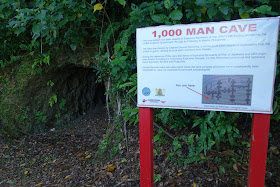 |
| Island booze |
Japan occupied what is now the island nation of Palau until they were dislodged in one of the bloodiest battles of the Pacific War, at Pelileu island, about an hour by speedboat south of Palau's main island, Koror. People still visit Pelileu to see the war remnants, such as the impressive cave structures the Japanese built beneath the island. While we were there, our fellow guests at Dolphin Bay Resort, a retired U.S. Marine and his military historian brother, found two Japanese bayonets in one of these caves, more than 70 years after the battle. (They turned them in to the local history museum.)
The greater attraction of Pelileu, however, is the scuba diving, which is up there with the very best in the world. We were wowed by it more than 20 years ago, and this year we were happy to visit again and stay with the same innkeepers, local expert Godwin and his Japanese wife Mayumi.
In fact, as in Hawaii, Japan may have lost the war but it has more or less won the island anyway. Most Americans don't know about the great diving in Pelileu, which is better than anywhere in the Caribbean. But Japanese know: there are direct flights from Tokyo to Koror. Mayumi told us Japanese tourism has fallen off in the last few years as non-diving Chinese tourists have flooded the island for the snorkeling, which also must be world-class as the light-blue water is so clear and there are astonishing schools of colorful tropical fish. But there is still plenty of Japanese-tourism infrastructure, which always means reliably clean rooms, and in this case also meant uniquely delicious shochu.
 |
| I saw bats and big spiders, but no bayonets (or Japanese ghosts) |
Most Americans underestimate shochu. Generally about 25% alcohol, it's a distilled spirit most famous from Kyushu, the southernmost of Japan's four main islands. On Kyushu, which is mostly too hot for rice production and thus sake is unusual, shochu made from sweet potatoes ("imo shochu") is the main alcoholic beverage. Shochu is drunk before dinner on the rocks, with dinner on the rocks, and after dinner straight up. Good Kyushu shochu tastes of sweet potato.
Most shochu you see in the U.S. is not that interesting, as it is basically low-proof vodka, distilled from grain at an alcohol percentage low enough to allow it to be served in restaurants that only have a beer and wine license. Koreans have been more successful marketing their version, called Soju, to these restaurants: when you see cocktails on menus at places that have no bar, it's usually flavorless soju. Nothing wrong with that, but shochu can be much more.
I was excited to try the cassava-taro shochu for its uniqueness, but I didn't expect much because I don't particularly like taro: it's just too bland for me. But with Shochu Nagomi, this was a feature not a bug. It's not as intensely flavorful as a shochu made from sweet potato, but it does have a mild vegetable flavor that's mostly fresh potato with a green note. If you know kohlrabi, I'd compare it to that. (If you don't know kohlrabi, try steaming it and mashing it like mashed potatoes: it's pretty similar but slightly more interesting.)
Shochu Nagomi probably tastes similar to what the Japanese military drank during WWII on many of the occupied islands, but of course with modern technology it's cleaner than back then, and while drinking it we did not have to contemplate any more challenging battles to come than what to order for dinner. It was nice on the rocks at the end of a diving day in fish paradise.
******
 |
| Thanks to Harlan (left) and Chris for taking us to the sharks |
Well that's nice but how about some more pictures for us that will never get there, Please;-)
ReplyDeleteSorry Jo, but most of our best views were underwater and I don't take dive photos these days. Imagine lots of fish!
ReplyDelete